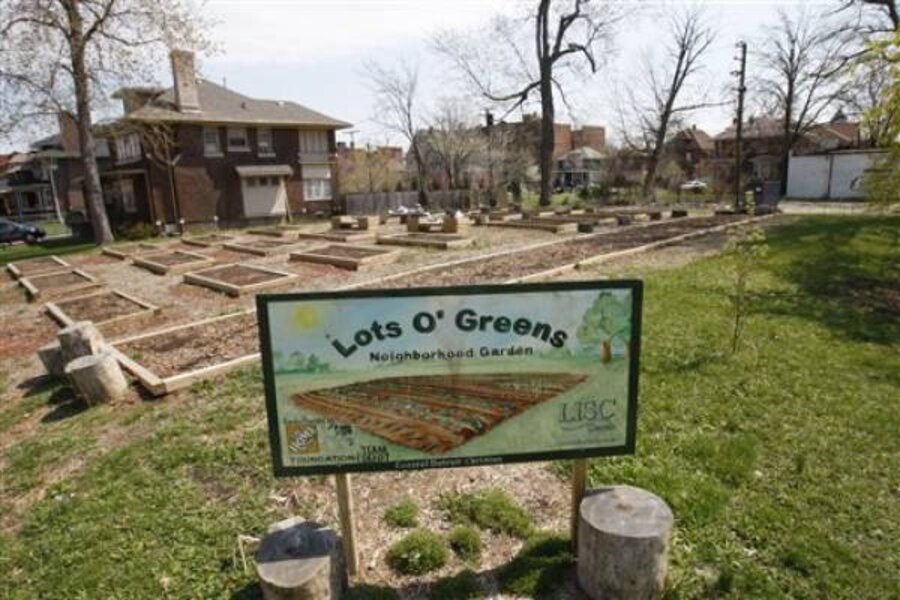Detroit leads the way in urban farming
Loading...
| DETROIT
Detroit, which revolutionized manufacturing with its auto assembly lines, could once again be a model for the world as residents transform vacant, often-blighted land into a source of fresh food.
With growing interest in locally raised food, cities including New York, Los Angeles, and Seattle are looking at ways to foster and manage urban agriculture. San Francisco's mayor has proposed creating community gardens on vacant public land citywide.
But no city seems to have as much potential for urban farming as Detroit, where land is cheap, empty lots are plentiful, and residents are desperate for jobs. The number of community gardens has been growing each year, and bigger, commercial agriculture could be coming as city planners draw up land use rules for farming.
Vacant land to be put to good use
"Most other cities aren't quite ready to think about large-scale agriculture," said Michael Score, president of Hantz Farms, which has plans to create the world's largest urban farm in the city. "We have vacant land and that used to be something that we were ashamed of."
Decades of population decline left Detroit with an estimated 40 square miles — more than 25,000 acres — of vacant property, and gardens have sprung up on empty lots in many neighborhoods. Often, they are just a few rows of greens and tomatoes. Others are more akin to small farms and include lots next to homes where pigs or goats roam behind fences and honeybees buzz.
The vacant property in Detroit covers nearly the same space as the entire city of San Francisco. New York, which has more than twice as much land as Detroit, has only an estimated 11,000 vacant acres, according to its planning department.
Farming was a big part of Detroit from the 1700s until the early 20th century, when a building boom pushed most agriculture outside the city limits.
Is bigger better?
This year, Detroit could again see commercial crops. Hantz Farms is in talks with the state to use 40 acres of the state fairgrounds for a demonstration farm before expanding to other parts of the city. It plans tightly packed rows and greenhouses, where it will raise fruit and vegetables as well as plants for landscaping. Less lucrative commodity crops such as corn, soybeans and wheat aren't part of the plan.
John Hantz, a Detroit resident who runs a network of financial services businesses, has promised to invest $30 million in the project aimed at creating jobs, providing fresh food to residents, and making the city a leader in urban farming.
The plan has sparked some skepticism among the community growers who have been the driving force behind agriculture in Detroit. Hantz Farms says there's room in the 139-square-mile city to coexist, but community activists worry that a bigger, for-profit venture might not benefit Detroit residents.
"What's making urban agriculture interesting and sustainable is the small scale. A few lots in a community, potentially bringing some produce to market," said Frank Donner, who has helped run the Birdtown Community Garden in the Cass Corridor neighborhood for the past six years. "If you start getting bigger, it loses its niche."
At Birdtown, gardeners share the work as well as the fruit and vegetables they grow each year. Dug in the ground where an apartment building burned about 15 years ago and was never rebuilt, Donner said the garden has become "a wonderful source of not just produce but friendship and community."
At least one nonprofit, however, also wants to get into large-scale agriculture in the city. Self-Help Addiction Rehabilitation Inc., which specializes in substance abuse treatment, has proposed RecoveryPark, a 10-year, $220 million project that would create organic farms in four struggling neighborhoods.
The plan calls for about half of 2,000 acres to be used for 15- to 30-acre organic farms, with the rest used for education, commercial and housing development, parks and other green spaces.
The organization is waiting to see the city's new agriculture zoning regulations, but it expects to use land now owned by the city, state, schools and land banks, said Gary Wozniak, the nonprofit's chief development officer. The land could be bought or leased or held in trust, he said. The farms would employ recovering addicts as well as neighborhood residents.
"It's really a big job creation engine," Wozniak said. "We're looking to rebuild these neighborhoods."
Land-use rules being developed
Such projects — tailored to Detroit, but potential models for other cities — are gaining momentum as planners draw up the first land use rules governing agriculture since Detroit became urbanized. They are considering an agricultural district, where a wider variety of farming activities might take place, and specific rules would address how and where chickens, rabbits, other farm animals and bees could be kept.
A partial draft released last month provides a vision for agriculture in a postindustrial city. It lists 20 goals that include environmental, economic, social, and health benefits. By putting vacant land to use, planners also hope to discourage the illegal dumping that's a problem in blighted neighborhoods.
"My personal hope," said Kathryn Lynch Underwood, a city planner who grew up gardening in the South, "is that the model that we roll out benefits as many people across the board in a city that really needs people to be employed and engaged in meaningful work."
-----
Editor's note: To read more about gardening, see the Monitor's main gardening page and our lively gardening blog, Diggin' It. Both of these have changed URLs, so we hope you'll bookmark them and return. Want to be notified when there's something new in our gardening section? Sign up for our RSS feed.






